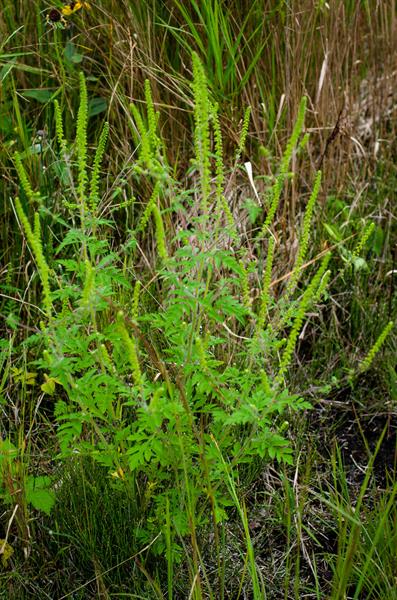
Origin/Endemic status: Native
Synonymy: = Ar, Bah, C, Fl7, G, GrPl, Il, Mex, Mi, NcTx, NE, NY, Oh3, Ok, Pa, Tn, Tx, Va, WH3, McMillan & Prevost (2022); < Ambrosia artemisiifolia L. – FNA21, K3, K4, RAB, SE1; > Ambrosia artemisiifolia L. var. artemisiifolia – F, K1, K2; > Ambrosia artemisiifolia L. var. elatior (L.) Descourt. – F, K1, K2, Tat; > Ambrosia artemisiifolia L. var. paniculata (Michx.) Blank. – F, K1, K2; > Ambrosia elatior L. – S; > Ambrosia glandulosa Scheele – S; > Ambrosia monophylla (Walter) Rydb. – S
Wetland Indicator Status:
- Atlantic and Gulf Coastal Plain: FACU
- Eastern Mountains and Piedmont: FACU (taxonomic split from wetland indicator species)
- Great Plains: FACU (taxonomic split from wetland indicator species)
- Midwest: FACU (taxonomic split from wetland indicator species)
- Northcentral & Northeast: FACU (taxonomic split from wetland indicator species)
Heliophily: 8
Hover over a shape, letter, icon, or arrow on the map for definition or see the legend.
 © Richard & Teresa Ware CC-BY-NC, permission granted to NCBG | Original Image ⭷
© Richard & Teresa Ware CC-BY-NC, permission granted to NCBG | Original Image ⭷ © Richard & Teresa Ware CC-BY-NC, permission granted to NCBG | Original Image ⭷
© Richard & Teresa Ware CC-BY-NC, permission granted to NCBG | Original Image ⭷ © Gary P. Fleming | Original Image ⭷
© Gary P. Fleming | Original Image ⭷ © Joey Shaw source | Original Image ⭷
© Joey Shaw source | Original Image ⭷ © Joey Shaw source | Original Image ⭷
© Joey Shaw source | Original Image ⭷ © Erik Danielson source | Original Image ⭷
© Erik Danielson source | Original Image ⭷ © Radford, Ahles and Bell | Original Image ⭷
© Radford, Ahles and Bell | Original Image ⭷Feedback
See something wrong or missing on about Ambrosia artemisiifolia? Let us know here: (Please include your name and email if at all complicated so we can clarify if needed.)
Cite as...